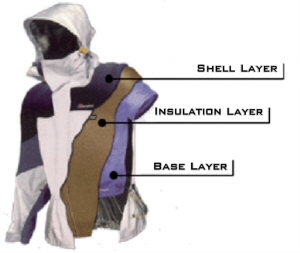Base Layer
The first layer is the base layer this layer of clothing will be in direct contact with your skin. The material should be thin and cool allowing you to wear it alone when you are overheated. It should keep you both cool and dry by wicking moisture away from your skin.
Excellent materials for base layers include:
- Coolmax
- PolarTec
- Capaline
Insulation Layer
The second layer of clothing is the insulation layer. This layer works by trapping still air space around your body, limiting the amount of heat loss. In general the more loft a material has the more still air space and so the more body heat it is able to retain. The insulation layer is the thickest.
Excellent materials for base insulation layers include:
- Fleece
- Bunting
- Pile
Shell Layer
The last layer is the shell layer. Its main responsibility is to keep wind and water from penetrating into the inner layers. This outer shell should also be able to expel the water vapor that collects inside your clothing from perspiration. Vulnerable areas include the seams and zippers. Be sure that seams and zippers are either well sealed or shielded.
Excellent material for base Shell layer include:
- Gore-Tex
- Conduit
- H2NO
Footwear
Waterproof boots are a critical to any survival clothing system, as in the shell layer Gore-Tex is available for boots also. Of equal importance when considering boots is comfort and stability. Studies have shown that wearing one extra pound on your feet takes as much energy as carrying five or six pounds in a backpack. With the added weight of supplies from you BoB, pressures on your feet can be extreme. Combine that fact with the elements and rugged terrain and you can wear your feet out quickly.
Socks
Socks are vital in keeping the feet warm and free of moisture. When looking for a good inner sock you should look for fabrics that are smooth against the skin and have the ability to wick moisture away from your feet, like wool or polypropylene. Keep socks as clean and moisture free as possible to prevent fungal infections and other ailments.

